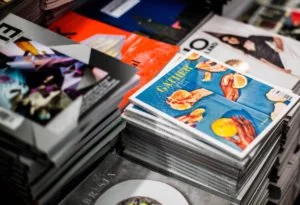People who work in the printing sector are all too familiar with flexographic printing. Yet, many don’t have any context for it or know what it’s used for.
In truth, flexographic printing is everywhere and has been for decades. Almost everything printed today can actually be produced through flexography. You see examples of it on snack bags, candy wrappers, cereal boxes, plastic shampoo bottles, notebooks, desk calendars, and even on a roll of printed paper towels.
In this article, we delve into the intricacies of flexographic printing, its process, and its differences with other types of printing methods.
What does flexographic printing mean?
Flexo printing isn’t exactly new technology, but it has considerably evolved through the years with many developments. These innovations make it one of the most reliable methods in producing mass volumes of high-quality custom labels at unparalleled speeds. Flexographic printing examples include shrink-sleeve and adhesive labels (bottle wraps), shopping bags, folding cartons, ice cream cartons, gift wrap, pouches, plastic bags, tissue, envelopes, and wallpaper – among many other things. In fact, about 60% of the packaging industry uses flexographic printing.
Flexo printing is a technique that uses a flexible printing plate. Most businesses nowadays use flexible photopolymer printing plates but, in the past, the plates were made of rubber. Flexography was actually derived from rubber stamp printing, which was popular in the early 1900s. However, the FDA eventually deemed the inks used in rubber stamp printing as unsafe for food packaging. Changes were then made to the inks used and the process was renamed.
How does flexography printing work?
The flexographic printing process consists of two major steps: pre-press and the actual printing.
Pre-press
The pre-press flexographic printing process is extremely important. This is a high-speed process, which means that inaccuracies in platemaking or preparing the artwork will lead to a lot of wasted ink and materials. Creating a design that fits the exact specifications required to produce the final print is vital. Failure to do so can result in costly mistakes.
It’s also important to keep in mind that the plate will likely lead to image enlargement. This because the flexible plate stretches when it is attached to the plate cylinder.
Printing
Each flexographic printing press has multiple printing stations, depending on the number of colors your need. Each station prints a single color. This means the printing material or substrate passes through many printing stations.
For each printing station, a roll of substrate passes through multiple flexible rotary plates. Each flexible plate is used for a single printed color. The printing plates derive their colors from specialized rollers which pass the inks onto the plates.
The flexographic printing process uses these types of rollers:
- The fountain roller passes the proper colored ink to the anilox roller.
- Often called the heart of the flexographic printing press, the anilox roller is shaped as a hard cylinder and is usually comprised of materials such as steel or aluminum. The surface of anilox rollers is covered with many fine pores, allowing rollers to pass precise amounts of ink onto the printing plate cylinder.
- The printing plate cylinder and impression cylinder are used simultaneously to apply pressure to the substrate that passes through them. This transfers the colored ink from the printing plate onto the printable material.
What is flexographic printing used for?
As its name indicates, flexographic printing is often touted as the most flexible printing method. It can be used for almost any application and it has endless, unique combinations of plates, cylinders, sleeves, and press types to achieve the desired end results.
With proper ink selection, flexo printing produces clear and attractive prints on nearly any substrate. As a result, it’s a popular choice among industries that want to print well-branded, eye-catching, and attractively designed consumer products.
Top markets that use flexo printing
It’s nearly impossible to list down all its applications but the major flexographic printing examples include: consumer products, school and office supplies, medical and pharmaceutical products, marketing materials, and product packaging.
Consumer products
The most common flexographic printing examples for consumer products are paper towels and tissue. Specialized flexo sleeves and printing cylinders can produce laser engraved print rolls ideal for both tissue and non-woven paper products.
School and office supplies
Flexo printing offers both consistency and precision, making it the perfect choice for printing ruling products such as stationery, legal pads, graph paper, lined notebooks, medical charts, and steno pads.
Marketing materials and product packaging
Any business can make use of flexographic printing to ensure their products are sold in beautifully designed and excellently printed packaging. Flexo printing is also often used to create mass-produced product display materials using any substrate.
What is the difference between digital and flexo printing?
In a previous article, we discussed digital printing vs. offset. Now, let’s focus on digital printing vs. flexography.
The decision between digital and flexo printing for your packaging labels can be a difficult one, especially if you want to ensure brand recognition and relay important product information. Let’s go over some of the differences between digital and flexo printing so you have a better idea of which one is right for your needs.
Pros of flexographic printing
The process works well with almost any label material, making it a great option if you need your design printed onto a specific substrate, or you need to include foiling or lamination in the process. Additionally, if you need to match an exact Pantone color, flexography will always be the correct shade. It is also the more cost-effective method for long print runs.
Cons of flexographic printing
Each color requires its own custom-made plate. You will need many plates for intricate designs. This makes it not so ideal for short runs due to the high cost.
Pros of digital printing
Digital printing allows you to print an exact and clean image every time — quickly in a single pass without the use of plates. You can also easily make any versions of the image without the need for another set of plates.
Cons of digital printing
Digital printing can only be used on certain materials. If you want to add foiling or lamination, it will need to be done by a separate process. Also, digital printers use a method of mixing toners to achieve the right color so exact Pantone color matches are often not viable.
What is the difference between offset and flexo printing?
Even though offset printing and flexo printing methods overlap widely in terms of meeting printing needs, there are a number of key differences that set them apart:
- Offset presses print indirectly through a series of offset plates while flexography prints directly on the substrate using rotary flexible plates.
- Offset printing uses secondary die-cutting, laminating, or folding processes whereas flexo printing integrates all these processes into a single pass operation.
- Offset printing only works with flat and smooth surfaces. Flexography can print on porous, non-porous, absorbent, and non-absorbent materials.
Flexographic printing advantages and disadvantages
Now that we’ve gone through what flexographic printing is, its process, its applications, and its major differences with other popular printing methods — what are its pros and cons? These are essential parameters in your overall decision-making process. Let’s go over them.
Advantages of flexo printing
- Suited for long printing runs
- Runs at extremely high speeds
- Short set-up times with minimal waste
- Guarantees high-quality output
- Removes the need for additional cost and work as printing, laminating, varnishing and die-cutting can be done in a single pass
- Low cost of equipment and maintenance
- A relatively controlled and straightforward printing process that requires less-trained operators to achieve desired results
Disadvantages of flexo printing
- The price of flexographic printing plates is relatively more expensive compared to other types of plates. But when properly cared for, they last for millions of impressions.
- Version changes can be time-consuming to make
Key takeaway on flexographic printing
Of course, each printing process has its own advantages and unique features. Still, flexo printing is a leader in the industry due to its versatility, quick production, little maintenance, and automation. Flexography combines printing and other processes (lamination, die-cutting, foiling, etc.) into a single pass, producing beautiful and vibrant prints in a fast and efficient manner.
It is for good reasons that flexographic printing has become the method of choice for companies in demanding sectors such as food and beverage, consumer packaged goods, cosmetics, and pharmaceutical industries.



